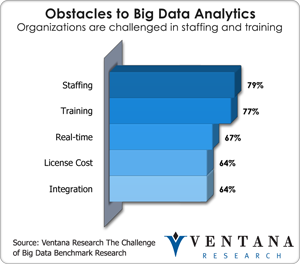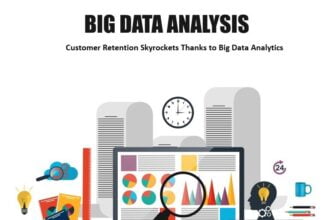This year’s Inspire, Alteryx’s annual user conference, featured new developments around the company’s analytics platform. Alteryx CEO Dean Stoecker kicked off the event by talking about the promise of big data, the dissemination of analytics throughout the organization, and the data artisan as the “new boss.” Alteryx coined the term “data artisan” to represent the persona at the center of the company’s development and marketing efforts.
This year’s Inspire, Alteryx’s annual user conference, featured new developments around the company’s analytics platform. Alteryx CEO Dean Stoecker kicked off the event by talking about the promise of big data, the dissemination of analytics throughout the organization, and the data artisan as the “new boss.” Alteryx coined the term “data artisan” to represent the persona at the center of the company’s development and marketing efforts. My colleague Mark Smith wrote about the rise of the data artisan in his analysis of last year’s event.
President and COO George Mathews keynoted day two, getting into more specifics on the upcoming 8.5 product release.  Advancements revolve around improvement in the analytical design environment, embedded search capabilities, the addition of interactive mapping and direct model output into Tableau. The goal is to provide an easier, more intuitive user experience. Our benchmark research into next-generation business intelligence shows buyers consider usability the top buying criteria at 63 percent. The redesigned Alteryx interface boasts a new look for the icons and more standardization across different functional environments. Color coding of the toolbox groups tools according to functions, such as data preparation, analytics and reporting. A new favorites function is another good addition, given that users tend to rely on the same tools depending on their role within the analytics value chain. Users can now look at workflows horizontally and not just vertically, and easily change the orientation if for example they are working on an Apple iPad. Version 8.5 allows embedded search and more streamlined navigation, and continues its focus on a role-based application, which my colleague has been advocating for a while. According to the company, 94 percent of its user base demanded interactive mapping; that’s now part of the product, letting users draw a polygon around an area of interest, then integrate it into the analytical application for runtime execution.
Advancements revolve around improvement in the analytical design environment, embedded search capabilities, the addition of interactive mapping and direct model output into Tableau. The goal is to provide an easier, more intuitive user experience. Our benchmark research into next-generation business intelligence shows buyers consider usability the top buying criteria at 63 percent. The redesigned Alteryx interface boasts a new look for the icons and more standardization across different functional environments. Color coding of the toolbox groups tools according to functions, such as data preparation, analytics and reporting. A new favorites function is another good addition, given that users tend to rely on the same tools depending on their role within the analytics value chain. Users can now look at workflows horizontally and not just vertically, and easily change the orientation if for example they are working on an Apple iPad. Version 8.5 allows embedded search and more streamlined navigation, and continues its focus on a role-based application, which my colleague has been advocating for a while. According to the company, 94 percent of its user base demanded interactive mapping; that’s now part of the product, letting users draw a polygon around an area of interest, then integrate it into the analytical application for runtime execution.
The highlight of the talk was the announcement of integration with Tableau 8.0 and the ability to write directly to the software without having to follow the cumbersome process of exporting a file and then reopening it in another application. Alteryx was an alpha partner and worked directly with the code base for Tableau 8.0, which I wrote up a few months ago. The partnership exemplifies the coopetition environment that many companies find themselves in today. While Tableau does some basic prediction, and Alteryx does some basic visual reporting, the companies’ core competencies brought together into one workflow is much more powerful for the user. Another interesting aspect is the juxtaposition of the two user groups. The visually oriented Tableau group in San Diego seemed much younger and was certainly much louder on the reveals, while the analytically oriented Alteryx group was much more subdued.
Alteryx has been around since 1997, when it was called SRC. It grew up focused around location analytics, which allowed it to establish foundational analytic use cases in vertical areas such as real estate and retail. After changing the company name and focusing more on horizontal analytics, Alteryx is growing fast with backing from, interestingly enough, SAP Ventures. Since the company was already profitable, it used a modest infusion of capital to grow its product marketing and sales functions. The move seems to have paid off. Companies such as Dunkin Brands and Redbox use Alteryx and the company has made significant inroads with marketing services companies. A number of consulting companies, such as Absolute Data and Capgemini, are using Alteryx for customer and marketing analytics and other use cases. I had an interesting talk with the CEO of a small but important services firm who said that he is being asked to introduce innovative analytical approaches to much larger marketing services and market research firms. He told me that Alteryx is a key part of the solution he’ll be introducing to enable things such as big data analytics.
Alteryx provides value in a few innovative ways that are not new to this release, but that are foundational to the company’s business  strategy. First, it marries data integration with analytics, which allows business users who have traditionally worked in a flat-file environment to pull from multiple data sources and integrate information within the context of the Alteryx application. Within that same environment, users can build analytic workflows and publish applications to a private or public cloud. This approach helps address the obstacles found in our research in big data analytics where staffing (79%) and training (77%) are addressed by Alteryx through providing more flexibility for business to engage into the analytic process.
strategy. First, it marries data integration with analytics, which allows business users who have traditionally worked in a flat-file environment to pull from multiple data sources and integrate information within the context of the Alteryx application. Within that same environment, users can build analytic workflows and publish applications to a private or public cloud. This approach helps address the obstacles found in our research in big data analytics where staffing (79%) and training (77%) are addressed by Alteryx through providing more flexibility for business to engage into the analytic process.
Alteryx manages an analytics application store called the Analytics Gallery that crowdsources and shares user-created models. These analytical assets can be used internally within an organization or sold on the broader market. Proprietary algorithms can be secured through a black box approach, or made open to allow other users to tweak the analytic code. It’s similar to what companies like Datameer are doing on top of Hadoop, or Informatica in the cloud integration market. The store gives descriptions of what the applications do, such as fuzzy matching or target marketing. Being crowdsourced, the number of applications should proliferate over time, tracking advancements in the R open source project, since R is at the heart of the Alteryx analytic strategy and what it calls clear box analytics. The underlying algorithm is easily viewed and edited based on permissions established by the data artisan, similar to what we’ve seen with companies such as 1010data. Alteryx 8.5 works with R 3.0, the latest version. On the back end, Alteryx partners with enterprise data warehouse powerhouses such as Teradata, and works with the Hortonworks Hadoop distribution.
I encourage analysts of all stripes to take a look at the Alteryx portfolio. Perhaps start with the Analytics Gallery to get a flavor of what the company does and the type of analytics customers are building and using today. Alteryx can benefit analysts looking to move beyond the limitations of a flat-file analytics environment, and especially marketing analysts who want to marry third-party data from sources such as the US Census Bureau, Experian, TomTom or Salesforce, which Alteryx offers within its product. If you have not seen Alteryx, you should take a look and see how they are changing the way analytic processes are designed and managed.









